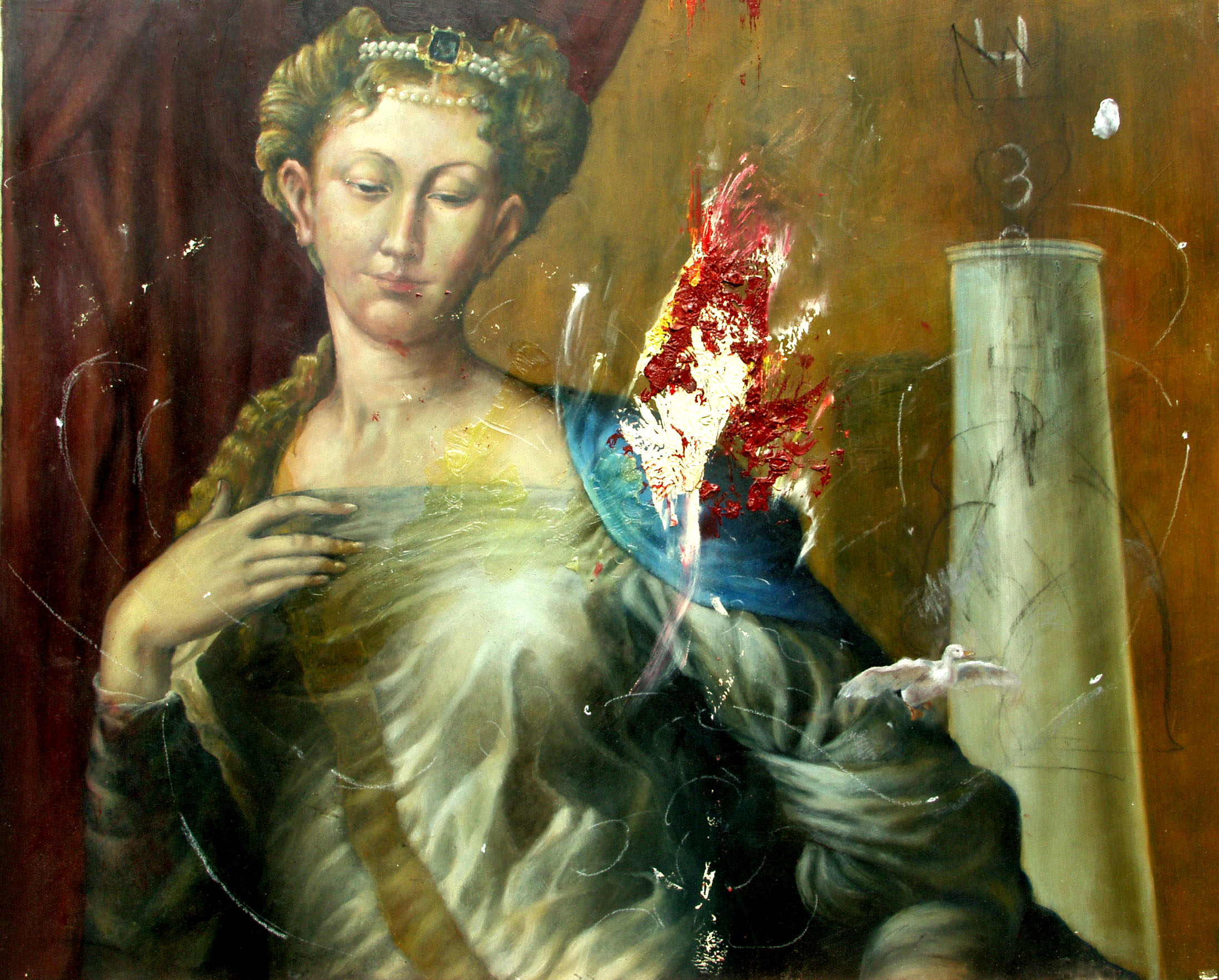From the brochure on the solo exhibition Kicking a Dead Horse, Rochester Art Center
text by Kris Douglas
“One becomes a painter when existing painted objects do not wholly satisfy one’s subjective unity of feling, the sense of one’s own identity. Any modern painter’s work is a criticism of the whole culture of painting from the standpoint of his identity. As we become more and more individualized historically, as the community begins to disintegrate, every painter feels more and more the necessity to reinvent painting””
The understanding of painting as a discipline has undergone numerous cycles of inquiry and resolution that have initiated transformations, revisions, and progressions throughout the vast history of the medium. While these conditions have fostered original and innovative approaches to technical and conceptual concerns, the tradition of painting and its associated conventions can also perpetuate cycles of replication, regression,
and stagnation. Some viewers of contemporary painting may gauge the success of a work based on aesthetic similarities to classical paintings of which they are familiar and that possess subject matter that is readily defined or understood. However, in contemporary art practice, artists determine the degree to which
they embrace or reject the accepted fundamental foundations of painting. In the quote above, renowned artist Robert Motherwell (1915-1991) addresses the painter’s desire to reinvent the medium in order to more fully align it with one’s own identity. In the exhibition Kicking a Dead Horse, Simon Huelsbeck similarly
addresses issues concerning personal identity and an ongoing process of simultaneously embracing and challenging the traditions and conventions of painting. Perhaps the best example of the culmination of these concepts is in the work Identity Crisis (2006). In this painting, Huelsbeck recreates a famous image by
Rembrandt van Rijn, Self Portrait at an Early Age (1628). Having been credited as one of the first artists to intensively study the self through drawing and painting, Rembrandt’s images exemplify expressions of emotion and human experience, as well as demonstrate a widely appreciated and often imitated technical style. That Huelsbeck selected this particular painting, perceptibly created at a time when Rembrandt himself was beginning his own artistic explorations of personal identity, suggests an appreciation, engagement, and evaluation of a similar process of desired understanding. That this work presents his own image in the place of the famous artist challenges and critiques tradition, the notion of the self, and the continuum
and influence of art history. In this work, Huelsbeck demonstrates not only his proficient technical abilities as a painter, but also the core conceptual underpinnings of his most recent body of work.
In his works Progress (2006) and Rochester Pop (2006), Huelsbeck redirects his attention from portraiture and contends with the traditions of landscape painting. The background of his oil painting Progress is a skillful recreation of an idyllic scene that features representations of tranquil waters reflecting a clouded sky and a powerful land mass, reminiscent of classic Hudson River School work. The viewer can readily see
Huelsbeck’s attention to light, layering, and perspective, again adopting the conventions and techniques of a recognized style. However attractive and subdued the representational landscape in the background, what is noticed, perhaps first, is the intrusion of a colorful mass, seemingly hovering on top of the landscape. Looking very much like the haphazard remnants of a painter’spalette, this is a direct aesthetic and conceptual challenge to the painting’s foundation. Thus the background and foreground appear quite at odds with
one another. While the landscape appears peaceful and somewhat serious or sophisticated with many fine details, the superimposed abstract amalgam of bold colors appears at once threatening, arbitrary, and somewhat absurd. In this way, he combines seemingly clashing methodologies and concepts and allows
for an atypical interaction, introducing questions of stylistic legitimacy and authority. Consider Huelsbeck’s title for this piece—Progress. He has taken a classical work and at once revered and attacked its conventions while alluding to aesthetic and conceptual evolution within the history of painting. Whereas in Progress a component of the work is applied over a traditional landscape, in Rochester Pop, Huelsbeck allows
his landscape to fully interact with and be transformed by a series of whimsical bubble-like structures. Although the muted colors and exacting details of the cityscape reference classic works, this landscape represents contemporary Rochester, Minnesota, the small city in which the artist lives and works. The bright colors and repeating forms included in this work reference design themes similar to those popular in the 1970s and in recent design, perhaps commenting on the current use of similar elements in contemporary drawing and painting. Unlike Progress, however, Huelsbeck allows these forms to combine and interact more fully with the landscape, becoming a more unified whole. In choosing to represent this city, Huelsbeck uses the notion of place and home to comment on identity. In doing so, he brings into question his role as teacher and community member, and his overall opinions about the city. Huelsbeck’s aesthetic
and conceptual concerns address a continued artistic effort to understand the
self and the meaning of art making.
